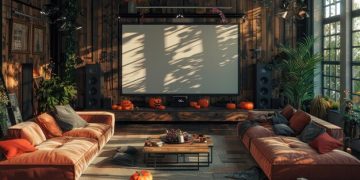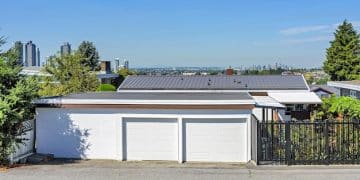DIY Soundproofing: Reduce Noise by 40% with Affordable Materials
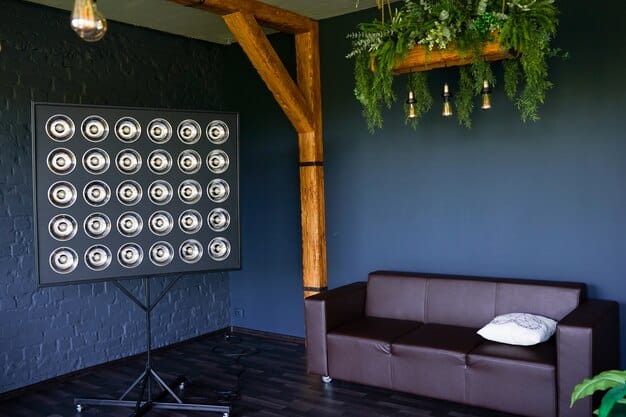
DIY soundproofing offers a practical and cost-effective solution to reduce noise levels by up to 40% using readily available materials, enhancing the comfort and functionality of your living or workspace.
Is noise disrupting your peace and quiet? You don’t have to spend a fortune on professional soundproofing. With simple and affordable materials, you can achieve significant DIY soundproofing, reducing noise by up to 40% and creating a more comfortable environment. Let’s explore how!
Understanding Sound and Noise
Before diving into DIY soundproofing, it’s helpful to understand the difference between sound and noise. Sound is any vibration that travels through a medium, such as air, and can be heard when it reaches a person’s or animal’s ear. Noise, on the other hand, is unwanted sound. What one person considers music, another might consider noise.
Types of Sound Transmission
Sound travels in two main ways: airborne and structure-borne. Addressing both is crucial for effective soundproofing.
- Airborne Sound: This includes sounds that travel through the air, like voices, music, and traffic noise.
- Structure-borne Sound: This refers to sounds that travel through solid materials, like footsteps on a floor or vibrations from machinery.
By understanding how sound and noise are transmitted, you can better target your soundproofing efforts.
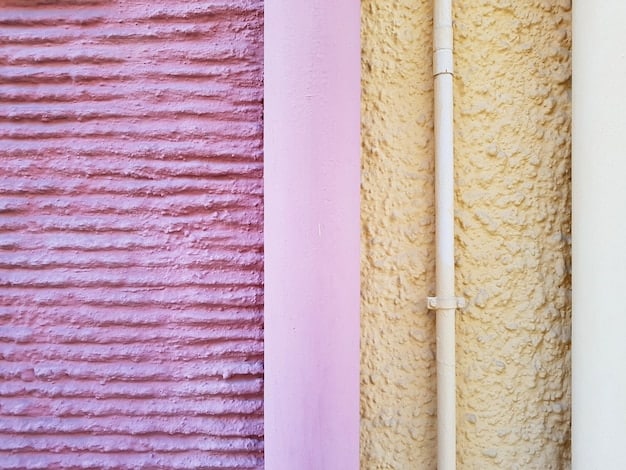
Affordable Materials for DIY Soundproofing
One of the best parts about DIY soundproofing is that you don’t need to break the bank. Many affordable materials can significantly reduce noise levels.
Common Soundproofing Materials
These are some effective and budget-friendly materials to consider for your DIY project:
- Acoustic Panels: These panels are designed to absorb sound waves, reducing echo and reverberation within a room.
- Mass-Loaded Vinyl (MLV): MLV is a dense, heavy material that acts as a sound barrier, blocking noise from passing through walls and floors.
- Soundproof Curtains: These curtains are made from thick, heavy materials that help to block outside noise and absorb sound within a room.
- Weather Stripping: Weather stripping seals gaps around doors and windows, preventing noise from entering through these openings.
These materials can be easily found at home improvement stores or online retailers, making them accessible for DIY enthusiasts.
Soundproofing Walls: Simple and Effective Techniques
Soundproofing walls can make a significant difference in reducing noise. There are several techniques you can use, depending on your budget and skill level.
Easy Wall Soundproofing Methods
Here are some simple ways to soundproof your walls:
- Add Fabric to Walls: Applying thick fabric wall hangings or tapestries can help absorb sound and reduce echo.
- Hang Soundproof Curtains: Covering walls with soundproof curtains can act as a barrier for noise coming across walls from other rooms.
- Install Acoustic Panels: Strategically placing acoustic panels on walls helps to absorb sound from external sources such as roads or loud neighbors.
Remember to focus on areas where sound is most likely to enter or exit the room for the best results.
Soundproofing Floors: Reducing Impact Noise
Footsteps and other impact noises can be particularly disruptive. Soundproofing your floors can significantly improve your living environment.
Effective Floor Soundproofing Strategies
Here are a few strategies to reduce impact noise:
- Add a Thick Rug: A thick rug with a dense pad underneath can absorb a significant amount of impact noise.
- Install Underlayment: Underlayment made of materials like rubber or cork can be installed beneath flooring to dampen sound, such as walking with shoes on indoors.
- Use Interlocking Floor Mats: They won’t stop noises from traveling from outside, but these mats are useful for decreasing indoor sounds from activities like exercise or walking around with shoes on.
These methods can help create a quieter and more comfortable space by minimizing the transmission of impact sounds.
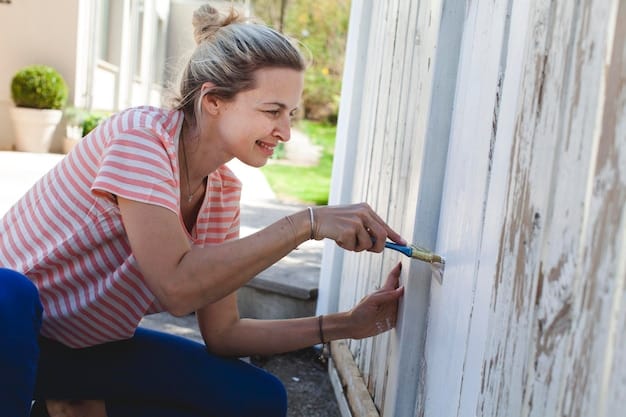
Soundproofing Doors and Windows: Sealing Gaps
Doors and windows are common entry points for noise. Sealing gaps around these openings is essential for effective soundproofing.
Sealing Techniques for Doors and Windows
Here are some ways to seal gaps around doors and windows:
- Apply Weather Stripping: Weather stripping can be applied around door and window frames to seal gaps and prevent noise from entering. This material can also help reduce drafts that increase cold air.
- Use Soundproof Curtains: Installing soundproof curtains or drapes can help to block noise from entering through windows, also providing added privacy.
- Install Door Sweeps: Door sweeps attach to the bottom of doors, sealing the gap between the door and the floor and keeping noise out. This can be especially helpful in areas where there are other tenants in the building.
Sealing these gaps can make a noticeable difference in reducing outside noise and improving your overall soundproofing efforts.
Creating a Quiet Workspace: Soundproofing for Productivity
A noisy workspace can hinder productivity and focus. Soundproofing your workspace can create a more conducive environment for concentration.
Tips for Soundproofing Your Workspace
Here are some tips for soundproofing your workspace:
- Use a Desktop Partition: Desktop partitions can help to block noise from neighboring workspaces, creating a quieter personal space.
- Add Acoustic Panels: Strategically placing acoustic panels around your workspace, such as on walls or ceilings, can help absorb sound and reduce echo.
- Utilize Noise-Canceling Headphones: These headphones can help block out distracting noises, allowing you to focus on your work.
By implementing these strategies, you can create a more peaceful and productive workspace.
Measuring Soundproofing Effectiveness
After implementing your DIY soundproofing measures, it’s helpful to measure their effectiveness. There are several ways to assess how much noise reduction you’ve achieved.
Methods for Measuring Sound Reduction
Here are a few methods for measuring sound reduction:
- Use a Sound Meter: A sound meter can measure the decibel level in your room before and after soundproofing, providing a quantitative measure of noise reduction. Sound meter apps on smartphones can provide a basic measurement as well.
- Record Ambient Noise Before and After: Recording ambient noise levels before and after soundproofing and comparing the recordings can provide a qualitative assessment of noise reduction.
- Subjective Assessment: Pay attention to how much quieter the room feels after soundproofing. While this is not a scientific measure, it can provide a general idea of the impact of your efforts. Does it feel like the outside noise is further away?
By using these methods, you can determine the effectiveness of your DIY soundproofing measures and make adjustments as needed.
| Key Point | Brief Description |
|---|---|
| 🏠 Acoustic Panels | Absorb sound, reducing echo and reverberation in a room. |
| 🚪 Sealing Gaps | Use weather stripping and door sweeps to block noise infiltration. |
| 🎵 Mass-Loaded Vinyl | Acts as a sound barrier, blocking the passage of noise through walls. |
| 🔊 Soundproof Curtains | Block outside noise and absorb sound to reduce indoor reverberation. |
FAQ
▼
The first step is identifying the primary sources of noise. Determine whether the noise is coming from outside, adjacent rooms, or within the room itself to target your efforts effectively.
▼
Yes, acoustic panels are effective for reducing echo and reverberation within a room. They work by absorbing sound waves, preventing them from bouncing off hard surfaces and creating noise.
▼
Mass-loaded vinyl works by adding density to walls or floors, creating a barrier that sound waves struggle to penetrate. This reduces the amount of noise that passes through various surfaces.
▼
While soundproof curtains can significantly reduce outside noise, they may not block it entirely. Their effectiveness depends on the thickness and density of the material, as well as how well they seal against the window frame.
▼
If external or internal sounds are disrupting your work, soundproofing your home office can be well worth the investment of time and resources. A reduction in disturbing sounds may significantly increase productivity, reducing unnecessary stress.
Conclusion
DIY soundproofing offers an affordable and effective way to create a quieter, more comfortable environment in your home or workspace. By understanding the principles of sound transmission and utilizing readily available materials, you can significantly reduce noise levels and improve your overall quality of life. Experiment with different techniques and materials to find the solutions that work best for your needs, and enjoy the benefits of a more peaceful and productive space.
